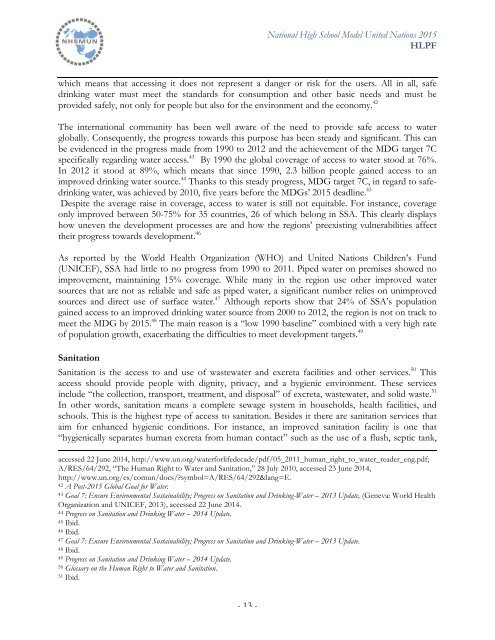d5MrHv
d5MrHv
d5MrHv
You also want an ePaper? Increase the reach of your titles
YUMPU automatically turns print PDFs into web optimized ePapers that Google loves.
National High School Model United Nations 2015<br />
HLPF<br />
which means that accessing it does not represent a danger or risk for the users. All in all, safe<br />
drinking water must meet the standards for consumption and other basic needs and must be<br />
provided safely, not only for people but also for the environment and the economy. 42<br />
The international community has been well aware of the need to provide safe access to water<br />
globally. Consequently, the progress towards this purpose has been steady and significant. This can<br />
be evidenced in the progress made from 1990 to 2012 and the achievement of the MDG target 7C<br />
specifically regarding water access. 43 By 1990 the global coverage of access to water stood at 76%.<br />
In 2012 it stood at 89%, which means that since 1990, 2.3 billion people gained access to an<br />
improved drinking water source. 44 Thanks to this steady progress, MDG target 7C, in regard to safedrinking<br />
water, was achieved by 2010, five years before the MDGs’ 2015 deadline. 45<br />
Despite the average raise in coverage, access to water is still not equitable. For instance, coverage<br />
only improved between 50-75% for 35 countries, 26 of which belong in SSA. This clearly displays<br />
how uneven the development processes are and how the regions’ preexisting vulnerabilities affect<br />
their progress towards development. 46<br />
As reported by the World Health Organization (WHO) and United Nations Children’s Fund<br />
(UNICEF), SSA had little to no progress from 1990 to 2011. Piped water on premises showed no<br />
improvement, maintaining 15% coverage. While many in the region use other improved water<br />
sources that are not as reliable and safe as piped water, a significant number relies on unimproved<br />
sources and direct use of surface water. 47 Although reports show that 24% of SSA’s population<br />
gained access to an improved drinking water source from 2000 to 2012, the region is not on track to<br />
meet the MDG by 2015. 48 The main reason is a “low 1990 baseline” combined with a very high rate<br />
of population growth, exacerbating the difficulties to meet development targets. 49<br />
Sanitation<br />
Sanitation is the access to and use of wastewater and excreta facilities and other services. 50 This<br />
access should provide people with dignity, privacy, and a hygienic environment. These services<br />
include “the collection, transport, treatment, and disposal” of excreta, wastewater, and solid waste. 51<br />
In other words, sanitation means a complete sewage system in households, health facilities, and<br />
schools. This is the highest type of access to sanitation. Besides it there are sanitation services that<br />
aim for enhanced hygienic conditions. For instance, an improved sanitation facility is one that<br />
“hygienically separates human excreta from human contact” such as the use of a flush, septic tank,<br />
!!!!!!!!!!!!!!!!!!!!!!!!!!!!!!!!!!!!!!!!!!!!!!!!!!!!!!!!!!!!!!!!!!!!!!!!!!!!!!!!!!!!!!!!!!!!!!!!!!!!!!!!!!!!!!!!!!!!!!!!!!!!!!!!!!!!!!!!!!!!!!!!!!!!!!!!!!!!!!!!!!!!!!!!!!!!!!!!!!!!!!!!!!!!!!!<br />
accessed 22 June 2014, http://www.un.org/waterforlifedecade/pdf/05_2011_human_right_to_water_reader_eng.pdf;<br />
A/RES/64/292, “The Human Right to Water and Sanitation,” 28 July 2010, accessed 23 June 2014,<br />
http://www.un.org/es/comun/docs/?symbol=A/RES/64/292&lang=E.<br />
42 A Post-2015 Global Goal for Water.<br />
43 Goal 7: Ensure Environmental Sustainability; Progress on Sanitation and Drinking-Water – 2013 Update, (Geneva: World Health<br />
Organization and UNICEF, 2013), accessed 22 June 2014.<br />
44 Progress on Sanitation and Drinking Water – 2014 Update.<br />
45 Ibid.<br />
46 Ibid.<br />
47 Goal 7: Ensure Environmental Sustainability; Progress on Sanitation and Drinking-Water – 2013 Update.<br />
48 Ibid.<br />
49 Progress on Sanitation and Drinking Water – 2014 Update.<br />
50 Glossary on the Human Right to Water and Sanitation.<br />
51 Ibid.<br />
- 13 -


